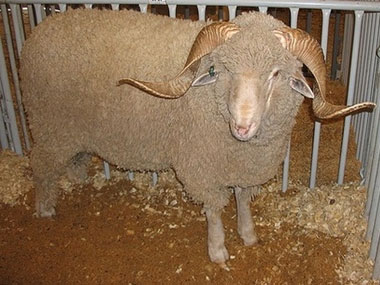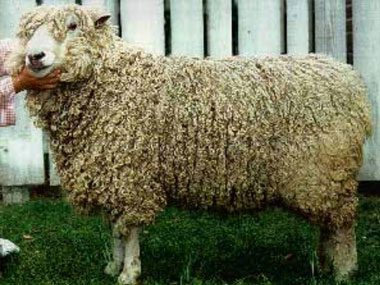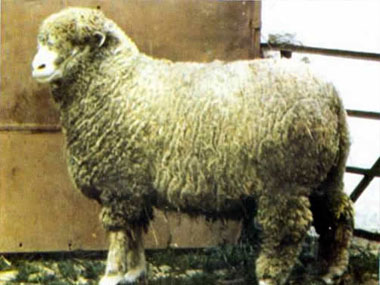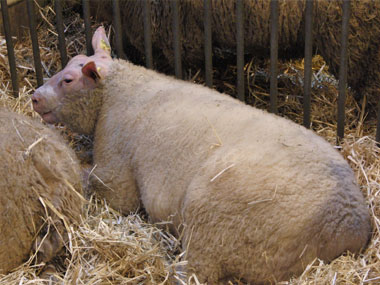Historical background that lead the way to the breeding of the Ile de France.
The famous Robert Bakewell, was well known in England for his skills in animal breeding. He did excellent work regarding performance and progeny testing results. His Dishley Leicester rams were well sought after in England as well as elsewhere. On 15 June 1786 a group of 334 Spanish Merino ewes and 42 rams left from Villa Castin in Spain to King Louis XVI as a gift. They travelled the 900 km journey over mountains and valleys, in snow rain and poor grazing to Rambouille in France. On 12 October of the same year 318 ewes and 41 rams reached their destiny. This herd is still in existence and is known as the Rambouille Merino.
These sheep played an important role in the development of the wool sheep in France during the reign of King Louis XVI and Napoleon I. During the collapse of the wool industry in the early 19th century, breeders started to select for meat quality. During 1824, Prof. Auguste Yvard from the National Veterinary College, Maisons-Alford started with crossbreeding with different sheep breeds. It was only during 1832 that he crossed Dishley rams with Rambouillet ewes. His aim was to combine the precocity of the Dishley with the wool quality of the Rambouillet. These crosses were particularly successful he there for concentrated on these crossings. The wool quality was further improved by the addition of the fi ne wool Mauchamp Merino. These crosses were available to the farmers during 1840.
This new breed was initially known as the Alford. When the nucleus herd was transferred to the Grignon Agricultural College in 1879, it was then called Grignon. This breed quickly spread to the so called Ile de France territory which was well known for grain cultivar specially wheat and sugar-beet. In the productionprocess a number of by-products such as wheatstraw and sugar-beet pulp which could be utilized by the sheep.
During 1875 the Dishley crosses were for the first time permitted to compete at the Agricultural show in Paris. During 1900 they stopped crossing with the original breeds. During 1920 the Contentin
was introduced on a limited scale. This breed’s influence was very important. Since 1922 when the breed was known and accepted as the Ile de France, no further crosses were permitted. Performance Testing started in 1933 under the guidance of Prof. AM Leroy, the secretary of the
Society. The other sheep breeds in France only accepted Performance testing during 1959.
During 1960 breeders decided to concentrate on re-productive qualities mainly on fecundity. To achieve this goal, it became clear that progeny
testing was essential. On 11 December 1968 the Society ruled that performance and progeny testing be compulsory. During 1972, the world
known Ile de France experimental station at Verdilly was established.
The history of the Ile de France in South Africa can be traced back to 1903, when Madam Arnaud Ginchard sent a number of Ile de France sheep as a gift to the farming community of South Africa (De Panillac 1903). The sheep originated from the well-known breeder, Delacour from Gouzangrez. The number of sheep sent as a gift is not known. The sheep arrived in Table Bay harbour on 23 March 1903 and left the Concordia after being examined by a veterinary surgeon. A photo of the Ile de France ram was published in the Cape Argus of 29 April 1903 after release from quarantine. Further movements of the sheep are unfortunately not known. During the 1930’s great interest was experienced in South Africa for the breeding of slaughter lambs for export. Different well known mutton breeds were introduced by the Department of Agriculture and other organisations. It was also during this
period that crossbreeding programs lead to the development of breeds such as the Dorper, Dormer, Dohne and others (almost identical to a hundred years previously when the Ile de France was bred).
Shortly after the outbreak of the Second World War, Messrs. Frasers Limited imported a numberof Ile de France rams. These rams went to their farm, Aanvang in the Wepener district, where they were used on Merino ewes. This cross was very successful resulting that 33 ewes were presented to the Research Institution in Pretoria for further research purposes.
These animals performed very well on the following qualities: duration of the breeding season, lambing percentage, milk production, survival potential, as well as adaption to unfavourable climatic conditions. Due to the war no further imports were possible. It took another 30 years before Ile de France were again seen in South Africa. Dr. JH Hofmeyr, who was Director of “The Research Institute for Animal and Dairy Science”, saw that the Ile de France, which had further been improved in France, by sophisticated breeding and selection criteria, would make a meaningful contribution to the production of slaughter lams in South Africa. The main function as seen, was the discreet paternal use in crossbreeding with ewes of other breeds for the production of extensive slaughter lam production. The progeny of these sheep were later on sold to private breeders.
The final gain for the Ile de France in the RSA was through private imports during 1972 and 1973. Further imports also lead to among others, to the importation of National champions from France. Ile de France then registered as a direct entry breed with SA Stud Book and since 1974 breeders registered their Ile de France sheep. The Ile de France Club was founded in 1975 with Mr. JD Weir as Chairman. During 1980 the Ile de France Sheep Breeder’s Society was approved and registered with Mr. JD Weir as its first President.
Rambouillet
Origin: They were originally bred from the Spanish Merinos on the French farm Rambouillet, near Paris.
Characteristics:
• A fine soft wool and is known as the most important sheep breed in the wool industry.
• These sheep are big and muscular with their bodies covered with wool.
Dishley Leicester
Origin: Descended from Dishley in England
Characteristics:
• Was a very popular paternal line in crossbreeding
• Good wool quality
• Potential to gain weight at an early age
• Hardy under extreme weather conditions.
Mauchamp (today known as Merino Précoce)
Origin: Mauchamp in France
Characteristics:
• Silky type wool which was sought after at some stage.
• Has to stand back for the finer wool type
Cotentin
Origin: France
Characteristics:
• Exceptionally hardy
• Quick growth potential



